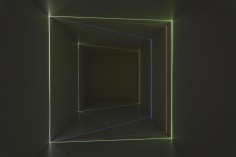CHRIS FRASER
克里斯·弗雷泽
Крис Фрейзер
كريس فريزر
in passing
source: disjectaorg
Disjecta is pleased to announce that Bay Area artist Chris Fraser, whose site-‐specific project In Passing is currently on exhibit, has been invited to participate in “Personal Structures: Time-‐Space-‐Existence #2,” an official collateral exhibition of the 55th Venice Biennale.
Personal Structures is an ongoing project initiated in 2002 by artist Rene Rietmeyer and subsequently organized by Curators Karlyn De Jongh and Sarah Gold. They have mounted Personal Structures exhibitions and symposia in Austria, Germany, The Netherlands, the United States and at the 54th Venice Biennale (“Personal Structures #1”), which included artist Peter Halley (NY), whose exhibition Prison followed at Disjecta in 2012.
“Every two years, the art world gathers in Venice…and my inclusion in Personal Structures affords me the rare opportunity to reach an international audience,” says Fraser. “I am on edge with excitement…and anxiety!”
Some of the most renowned artists of our time have been exhibited by Personal Structures. At the time of writing, the artist list for #2 has not been announced but the exhibition will include “28 artists from 12 countries and 5 continents in an extraordinary combination.” Artists invited for “Personal Structures #1” in 2011 included Marina Abramovic (RS), Peter Halley (US), Arnulf Rainer (AT), Rene Rietmeyer (NL), Carl Andre (US) and Lawrence Weiner (US).
“In Passing is the most ambitious project I’ve ever worked on, it’s the most ambitious project the artist has ever attempted, and it is, I hope, one of the most successful projects ever executed at Disjecta,” reflects Curator-‐in-‐Residence Josephine Zarkovich. “Chris is so deserving of the opportunity to exhibit internationally—it’s wonderful to see him go from the show at Disjecta to Venice.”
Chris Fraser’s work isolates and brings attention to the miraculous and mysterious qualities of light as it moves through architecture—powerful forces that usually go unnoticed in a space. His site‐specific, large‐scale structures act as modified camera obscuras, producing room‐sized abstract canvases painted with refracted streaks of light.
Born of careful study and meticulous experimentation, Fraser’s work takes the viewer to a moment of the sublime, where the way in which the eye perceives light is manipulated to dramatic effect. At his core, Fraser is not a sculptor as much as he is a photographer—he uses his understanding of color theory and optics to control what the viewer sees and, as Erica Levin writes of his work, “…remake(s) our relationship to the camera, and to the everyday production of images.”
Regarding In Passing, Fraser notes: “Disjecta presented me with the rare opportunity to work spontaneously and without limitation. I was given the resources, both in terms of material and labor, to pursue a project on a grand scale. My only obligation was to honor the scale of the gallery. The show developed out of a project I had shelved a couple years ago for lack of space. But it alone was not enough to fill Disjecta. At a certain point, I was forced to entertain each wild idea. In this way, I built a show that was as much a surprise for me as I hope it is for the visitors.”
Press for In Passing:
“This is one of those rare shows capable of generating sheer and utter joy across demographics”…” “It’s one of the best shows to ever fill Disjecta, and likely one of the best to brighten Portland all year. Don’t miss out.” Portland Monthly (March 6, 2013)
“The installation is a triumph for Fraser and a strong second outing for Disjecta’s 2013 Curator-in-Residence, Josephine Zarkovich.” Visual Art Source (January 2013)
“…the pleasurable disorientation of the artist’s updated take on the legacy of Light and Space … may be the best use of Disjecta’s generous exhibition space since the contemporary art center moved into its Kenton location.” the Oregonian (February 8, 2013)
“It’s one part James Turrell, one part 2001: A Space Odyssey. You simply have to see it.” Willamette Week (February 2013)
“He has built a camera obscura we can walk through, allowing us to experience the relationship between light, space and shape in very intentional, and frankly pretty cool, ways.” OPB Arts & Life (February 15, 2013)
Oregon Public Broadcasting Art Beat’s Katrina Sarson and Lynne Clendenin filmed an episode at Disjecta, using In Passing throughout.
About the artist
Fraser received his BA in history from the University of California, Davis and his MFA in studio art from Mills College. He is a recipient of the Jay DeFeo Prize and was a graduate fellow at Headlands Center for the Arts. He is a 2012 SECA award finalist. Fraser is represented by Highlight Gallery in San Francisco, CA.
“I would like my work to point back into the world…there is nothing particularly special about the light that enters these works. Echoes of this same order can be found in your home, entering your windows, skirting around furniture, slipping through a crack in the door.” –from “Chris Fraser”, In the Make (July 2012)
About Disjecta’s Curator-in-Residence Program
The Curator-in-Residence program provides an opportunity for emerging local and national curatorial talent to develop and expand the scope of their practice. During their one-year residency, curators engage a broad range of artists to create a series of exhibitions in Disjecta’s dynamic 3,500-square-foot space. By showcasing new work and fueling collaborations between artists, curators, and viewers, Disjecta seeks to impact new audiences and intervene in the larger contemporary arts dialogue. Josephine Zarkovich, MA in Curatorial Practice from the California College of the Arts, was selected as the 2012–2013 Curator-in-Residence. The CIR program receives major support from the Andy Warhol Foundation for the Visual Arts.


